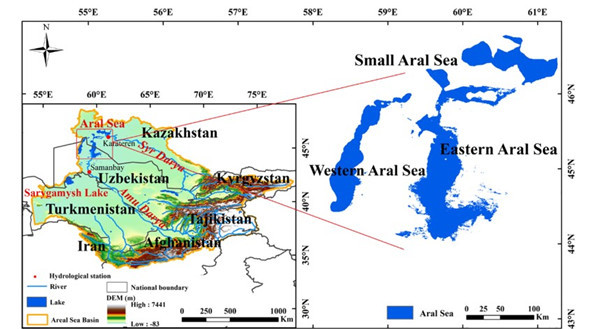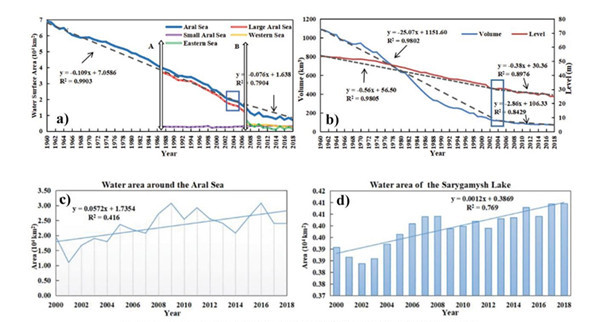Research indicates shrinkage rate of Aral Sea is slowing down
2020-08-03
Located on the border of Kazakhstan and Uzbekistan, the Aral Sea was once the fourth largest lake in the world. With sharp retreat of Aral Sea since 1960s, the river bed dried up and ecosystem seriously degraded, making the sea a world-renowned "Ecological Disaster Area".
Under the influence of both climate change and human activities, the Aral Sea retreated rapidly from 1960 to 2004, but the retreat has slowed since 2005.
Researchers from State Key Laboratory of Desert and Oasis Ecology, Xinjiang Institute of Ecology and Geography, Chinese Academy of Sciences, systematically analyzed the evolution trend of the Aral Sea over the past 50 years and the driving forces of the slowdown of retreat by using the extreme-point symmetric mode decomposition (ESMD) method and the multiple linear regression model.
The research results indicated that, from 1960 to 2004, the water area of the Aral Sea experienced a rapid shrinking process at a rate of 1087.00 km2/a. Since 2005, the shrinking rate has slowed down significantly (760.00 km2/a).
In contrast to the Aral Sea, the area and number of water bodies around the Aral Sea show an increasing trend. The oscillation periods of water level of the Aral Sea are 2.1a, 7.6a and 29.5a, of which 29.5a is the main period of oscillation.
The correlation between cropland and built-up area with water volume of the Aral Sea is more significant than that of temperature and precipitation. Specifically, the accelerated melting of glaciers and snow caused by global warming together with the increased mountainous precipitation have led to a rise in upstream runoff. And the water withdrawal in the basin decreased at a rate of 7.69×108 m3/a since 2005. The increased upstream runoff and decreased water withdrawal jointly resulted in the increase in water delivery to the Aral Sea, which led to a slowdown of the Aral Sea retreat. The increase in the water area around the Aral Sea is mainly due to agricultural drainage in the basin.
The research results entitled "The impact of climate change and human activities on the Aral Sea Basin over the past 50 years" was published on the Atmospheric Research.
Article link: https://www.sciencedirect.com/science/article/pii/S0169809520310619?dgcid=author

Figure 1. Location of the Aral Sea.

Figure 2. Trends in the Aral Sea water surface area (a) and water volume and water level (b) from 1960 to 2018, changes in water area around the Aral Sea (c) and at Sarygamysh Lake (d) from 2000 to 2018.
Contact: LIU Jie, Xinjiang Institute of Ecology and Geography
E-mail: liujie@ms.xjb.ac.cn



